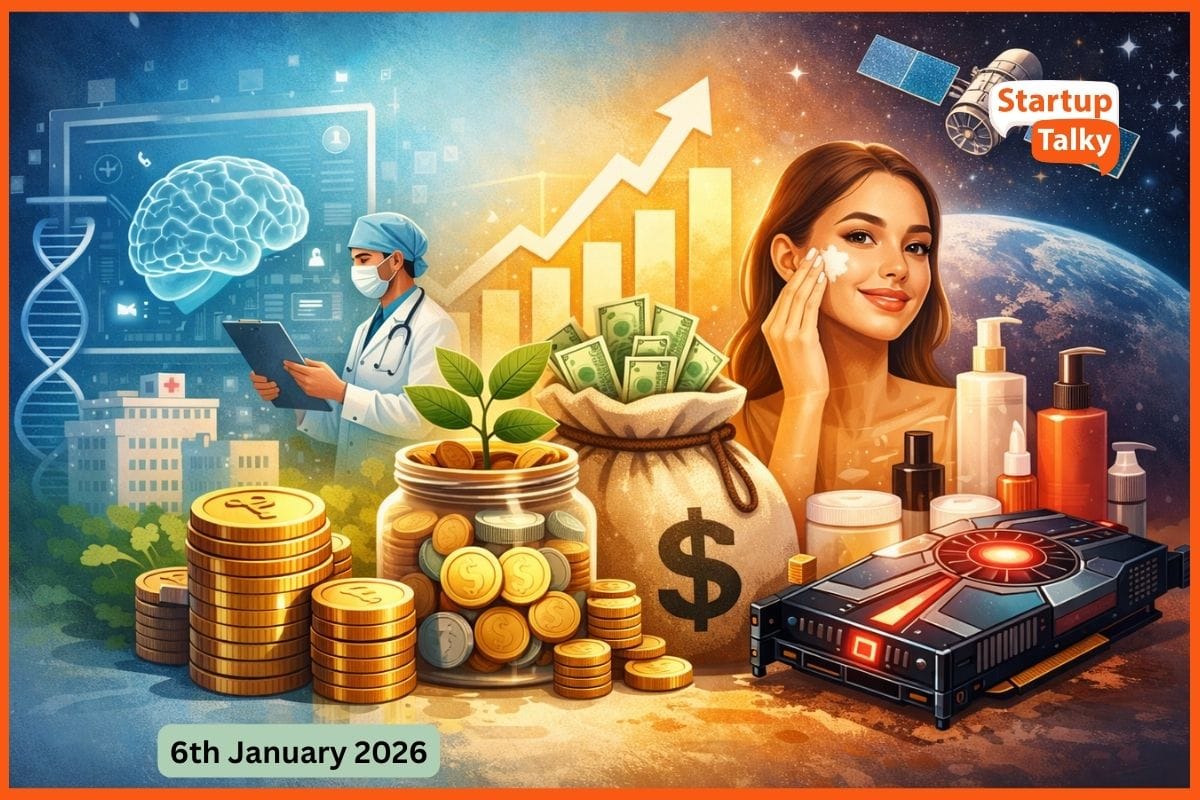Edtech Startups Using AR and VR in Education
Collections 🗒️
When I was studying in school I used to read textbooks, write in notebooks with a pen and see video modules on a projector.
Mainly the curriculum was based on reading and writing notes.
To be very frank, the conventional method of teaching was a bit boring.
But, now due to the advancements in technology a lot of edtech startups are harnessing the power of augmented reality (AR) to deliver innovative learning solutions.
Today, we will tell you about 4 startups that are using AR to revolutionize the education system.
Key Difference Between VR and AR
Key Difference Between VR and AR
Before we move forward it is very important to understand the key difference between AR and VR.
| Augmented Reality (AR) | Virtual Reality (VR) |
|---|---|
| AR is the integration of virtual information with the user's real-world environment. | Virtual reality (VR) creates a completely virtual environment that users can experience by wearing a VR headset. |
| AR bridges the gap between virtual objects and the real world. | VR is completely fictional. |
| A popular example of AR would be Pokémon GO | Games that you play by wearing headsets are examples of VR |
1. Veative Labs
| Startup Name | Veative Labs |
|---|---|
| Founded In | 2016 |
| Location | Central Delhi, India |

In 2016, Ankur Aggrawal founded Veative Labs with a vision to bring complex concepts to life using AR.
The startup wants to make learning fun and interactive for students.
Veative Labs has developed the world's first XR CHIP-enabled VR Headset that comes with preloaded AR content.
It also comes up with a hand-held controller that allows navigation and engages the students in the immersive learning environment of AR.
Teachers can blank the screen of the students' headsets to grab their attention.
They can even install, uninstall, and launch VR modules remotely on students’ headsets.
The startup has made 670+ interactive VR modules that cover subjects like Biology, Chemistry, Physics, and Maths.
Using AR students can get inside the human heart to understand how the heart coordinates with other organs or get inside a plant to learn about photosynthesis.
Students can interact with the objects and organize their VR modules as per their requirements. They can even create their own VR projects.
The in-built feedback and assessment tracker make sure that the learner stays on track.
The startup has developed its own proprietary reporting system which allows students, teachers, and parents to view the data.
Students can also learn how to speak English. The AR brings various situations in front of the learners that allow them to speak English.
Using voice recognition the AR will understand if the students are actually speaking or not.
It then provides instant feedback on pronunciation and speech.
Teachers can also virtually transport students to the world's great locations.
Students with special needs can learn in a judgment-free environment at their own pace using AR.
2. PlayShifu
| Startup Name | PlayShifu |
|---|---|
| Founded In | 2016 |
| Location | Bangalore, India |

In 2016, two old friends and new fathers, Vivek Goyal and Dinesh Advani founded PlayShifu with the vision of making the kid's screen time more meaningful.
PlayShifu develops AR toys that make education fun for children of ages 4-12 years.
In total, the startup has made 16 products.
Their 3 popular AR lineups include:
- Orboot Earth
- Orboot Dinos
- Orboot Mars
These are 3 unique globes powered by AR.
Orboot Earth gives the children access to 400+ highlights and 1000+ cool facts across 6 categories - cultures, cuisines, monuments, inventions, animals, and maps.
While with Orboot Dinos children can see how the earth looked 250 million years ago and discover 50+ 3D dinosaurs.
Orbit Mars allows children to explore the red planet and learn about orbiters, landers, and rovers in 3D. Children can discover 1000+ cool facts and 20+ spacecraft.
How do all these global works?
Children need to download an app on their iPad and scan the globe to interact with 3D models.
All these globes develop critical thinking among children.
Apart from this, the startup also makes STEM-based games where you get one gaming pad and 7 gaming kits.
All these AR-powered games help children learn about spelling, grammar, maths, animals and music.
PlayShifu also makes TACKO games where children can turn their tablet into a fun interactive board game and learn about chess, coding, animals and developing gadgets.
Tacto Doctor is an interesting product where children can turn their tablets into an interactive clinic.
They can treat a patient and learn what is the usage of certain instruments like stethoscopes and learn more about body parts like bones, stomach, and other organs.
As you can see, the startup has made a lot of AR toys that make education fun.
The startup is trusted by 1 million educators and parents across 35 countries.
In April 2021, PlayShifu raised Series B funding of $17 million from Inventus Capital India with Inflexor Ventures.

3. TutAR
| Startup Name | TutAR |
|---|---|
| Founded In | 2015 |
| Location | Kerala, India |

In 2020 Thomson Tom, Shyam Pradeep Alil, and Suvith S launched TutAR with a vision to revolutionize the Indian education system with the help of AR models.
The app is developed by Thrissur-based startup Infusory.
TutAR comes with preloaded AR content for science subjects for kindergarten and from classes 1 to 12th.
Teachers can access these VR models via any video conferencing software.
They can then record videos interacting with the augmented objects and share them on any social media channel.
No green screen setup or VFX is required.
According to the founders, if you know how to use a mobile phone you can easily use the app as well.
Once the app is downloaded teachers need to select the subject, topic, and AR model.
Teachers can show eye-popping 3D models of the anatomy of teeth, skulls, and muscles, Wheatstone bridges, potentiometers, Carnot engines besides them when they are teaching.
Teachers can change the size of the model, and rotate it up, down, right, or left according to their needs.
They can even draw something over the model. In this way, students will get a visual representation of the subject.
TutAR is used in 19+ states and 100+ institutions.
In April 2022, the edtech startup raised undisclosed seed funding from April Ventures, SalesboxAI's founder Roy Rajan.
The funding will help the startup to scale its operations. In the future, the founders want to expand their business outside of India.
They want to create a 'Meterverse' or in their words 'Tutarverse' where students and teachers can interact with each other using both VR and AR.
4. zSpace
| Startup Name | zSpace |
|---|---|
| Founded In | 2007 |
| Location | San Jose, California |

zSpace is an edtech startup that wants to provide innovative learning experiences to students using the power of VR and AR.
Paul Kellenberger founded this startup in 2007.
zSpace is a Windows-based AR/VR laptop that comes with glasses and a stylus.
Once you turn on the system and wear the glasses the magic happens!
Using the stylus students can bring objects out of the screen in 3D space.
They can then rotate the virtual objects or move them up or down or dissect them.
Students can move their heads around the object and see its intricate details.
Currently, zSpace is only focused on science and math. They also cover CTE programs which make students ready for college or work.
The laptop is suitable for kindergarteners as well as medical students.
zSpace also helps students get industry certifications in the following fields:
- Health Science and Public Service
- Advanced Manufacturing and Skilled Trades
- Agri-Science
- Transportation

Conclusion
As you can see with the help of AR learning complex concepts would be easy.
When AR is used to teach complex subjects like medical science, doctors get a chance to learn in a less anxious environment, practice their skills and equip themselves with futuristic methods.
With the boom of entrepreneurship and AR, we will surely see more applications of AR in education.
Global AR in the education market to expected to reach $41.8 billion by 2027, growing at a CAGR of 77.2% over the period 2020-2027.
In the future, it might happen that students will not have to carry any books and study via AR and VR tablets or headsets.
FAQs
How can AR be used in education?
AR can make classroom education more interactive and exciting. Teachers can show virtual examples and students can interact with those objects and see how a particular thing functions.
For example, teachers can show the human organs using AR and students can see in real-time how the human body functions. Since the human brain doesn't forget visuals, students will grasp concepts more easily.
What companies are using AR and VR?
Big companies like Microsoft and Meta are using AR and VR. Some other companies use AR and VR zSpace, WoofbertVR, Nearpod, etc.
Which is the number 1 Edtech company in India?
Byjus is considered as the number 1 Edtech company in India.
How are AR and VR used in education?
Using AR and VR in education enhances the learning experience for students and also allows them to grasp the concept with much clarity due to the availability of 3D visuals.
Must have tools for startups - Recommended by StartupTalky
- Convert Visitors into Leads- SeizeLead
- Website Builder SquareSpace
- Manage your business Smoothly Google Business Suite






